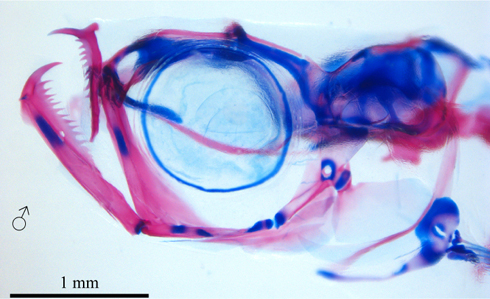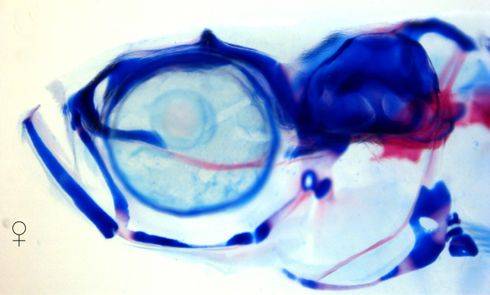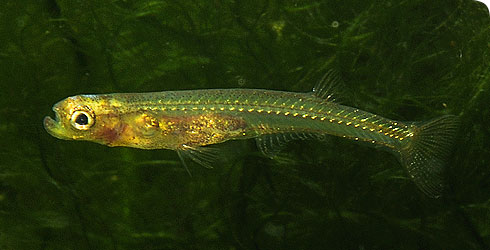Danionella dracula
Danionella dracula is the 3rd species to be discovered in a genus of miniature and highly developmentally-truncated carp-like fishes. It was described scientifically for the first time in 2009 by Museum scientists and their US collaborator.
The genus Danionella includes some of the world's smallest fishes and vertebrates.
Species detail

Danionella dracula males have tooth-like structures, shown here in an image of the head of a stained specimen (top) and a scanning electron micrograph of the mouth (bottom).
This fish is unique among the other 3700 species in the order Cypriniformes for the presence of jaw structures that look like huge teeth, which earned it the species name 'dracula'.
It is the largest species in the genus Danionella, with a maximum length of 16.7mm.
When alive, D. dracula is colourless and largely translucent, except for:
- 5 rows of melanophores
- melanophores capping the dorsal and dorsolateral surface of the gas bladder chambers and their connecting duct
- a thin yellow line running along the body at the level of the neural tube (the fish's central nervous system)
Very little is known about the biology or behaviour of any of the Danionella species.
-

Taxonomy
The tooth-like processes on the jaws of males which resemble canine fangs are probably the most striking feature of Danionella dracula and help distinguish it from the other 3 species in the genus. Learn more about these and other key characteristics.
-

Distribution and conservation
This miniature fish has been collected so far only from the type locality a small stream near Sha Du Zup belonging to the Irrawaddy drainage in northern Myanmar (Burma).
-

References
Get reference material relating to the 4 Danionella species.
Images

Live Danionella dracula female, showing the typical colouration pattern (image: Ralf Britz, Natural History Museum)

A living male specimen of the minature fish Danionella dracula (image: Ralf Britz, Natural History Museum)

Lateral views of Danionella dracula specimens which are in the Museum's collections. Top = the holotype (BMNH 2008.1.1.1) which is male, bottom = the paratype (BMNH 2008.2-99) which is female. (Images: Ralf Britz, Natural History Museum).

Scanning electron micrograph image of a male Danionella dracula specimen, showing the characteristic 'fangs' (image: Ralf Britz, Natural History Museum)

Close-up scanning electron micrograph of an anterior view of a male Danionella dracula specimen (image: Ralf Britz, Natural History Museum)

Stained specimen of a Danionella dracula male, showing the tooth-like processes present on the jaw (image: Ralf Britz, Natural History Museum)

Stained specimen of a Danionella dracula female (image: Ralf Britz, Natural History Museum)
About the author
Dr Lukas Ruber
Former Researcher in the Zoology Fish Research Group.
Toolbox
Glossary
Melanophores
Cells containing the pigment melanin.
